初三名词复习练习题
中考英语总复习名词练习题
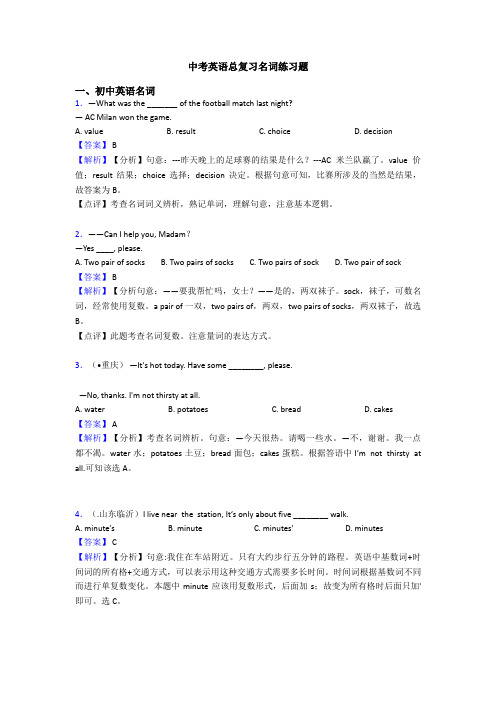
中考英语总复习名词练习题一、初中英语名词1.—What was the _______ of the football match last night?— AC Milan won the game.A. valueB. resultC. choiceD. decision【答案】 B【解析】【分析】句意:---昨天晚上的足球赛的结果是什么?---AC米兰队赢了。
value价值;result结果;choice选择;decision决定。
根据句意可知,比赛所涉及的当然是结果,故答案为B。
【点评】考查名词词义辨析,熟记单词,理解句意,注意基本逻辑。
2.——Can I help you, Madam?—Yes ____, please.A. Two pair of socksB. Two pairs of socksC. Two pairs of sockD. Two pair of sock【答案】 B【解析】【分析句意:——要我帮忙吗,女士?——是的,两双袜子。
sock,袜子,可数名词,经常使用复数。
a pair of 一双,two pairs of,两双,two pairs of socks,两双袜子,故选B。
【点评】此题考查名词复数。
注意量词的表达方式。
3.(•重庆)—It's hot today. Have some ________, please.—No, thanks. I'm not thirsty at all.A. waterB. potatoesC. breadD. cakes【答案】 A【解析】【分析】考查名词辨析。
句意:—今天很热。
请喝一些水。
—不,谢谢。
我一点都不渴。
water水;potatoes土豆;bread面包;cakes蛋糕。
根据答语中I’m not thirsty at all.可知该选A。
4.(.山东临沂)I live near the station, It‘s only about five ________ walk.A. minute’sB. minuteC. minutes’D. minutes【答案】 C【解析】【分析】句意:我住在车站附近。
九年级名词测试题及答案

九年级名词测试题及答案一、选择题(每题2分,共20分)1. The ________ is the largest organ in the human body.A. heartB. skinC. lungsD. liver2. The ________ is the most common means of transportation in many cities.A. bicycleB. carC. trainD. bus3. The ________ is the capital of the United States.A. New YorkB. Washington, D.C.C. Los AngelesD. Chicago4. The ________ is a popular sport among young people.A. soccerB. basketballC. volleyballD. tennis5. The ________ is the main course of a meal.B. soupC. saladD. entree6. The ________ is an important festival in China.A. ChristmasB. ThanksgivingC. Mid-Autumn FestivalD. Halloween7. The ________ is the largest ocean in the world.A. Atlantic OceanB. Indian OceanC. Pacific OceanD. Arctic Ocean8. The ________ is the highest mountain in the world.A. Mount EverestB. Mount KilimanjaroC. Mount FujiD. Mount Whitney9. The ________ is the most widely spoken language in the world.A. EnglishB. MandarinC. SpanishD. French10. The ________ is a traditional Chinese musical instrument.B. violinC. erhuD. guitar二、填空题(每题1分,共10分)11. The ________ is the first day of the week in many countries.12. The ________ is a large, long-necked mammal.13. The ________ is a type of fruit that is often red or green.14. The ________ is a type of flower that is often associated with love.15. The ________ is a type of insect that is known for its ability to fly.16. The ________ is a type of tree that is often associated with Christmas.17. The ________ is a type of bird that is known for its ability to swim.18. The ________ is a type of musical instrument that is played with a bow.19. The ________ is a type of drink that is made from coffee beans.20. The ________ is a type of animal that is known for its long trunk.三、改错题(每题1分,共10分)21. I have a lot of homeworks to do tonight. ___22. The informations about the event are available online.___23. She has a beautiful voices. ___24. There are many buildings in the cities. ___25. He gave me a good advices. ___26. The childrens are playing in the park. ___27. The news was very surprisings. ___28. They have two childs. ___29. The equipments in the gym are modern. ___30. She has a lot of experiences in teaching. ___四、翻译题(每题2分,共20分)31. 这个博物馆收藏了许多古代文物。
中考九年级英语名词专项练习(附答案)
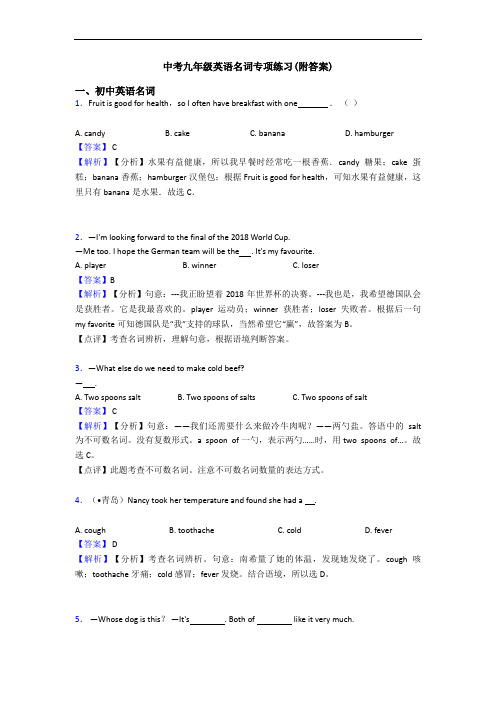
中考九年级英语名词专项练习(附答案)一、初中英语名词1.Fruit is good for health,so I often have breakfast with one .()A. candyB. cakeC. bananaD. hamburger【答案】 C【解析】【分析】水果有益健康,所以我早餐时经常吃一根香蕉.candy糖果;cake蛋糕;banana香蕉;hamburger汉堡包;根据Fruit is good for health,可知水果有益健康,这里只有banana是水果.故选C.2.—I'm looking forward to the final of the 2018 World Cup.—Me too. I hope the German team will be the . It's my favourite.A. playerB. winnerC. loser【答案】B【解析】【分析】句意:---我正盼望着2018年世界杯的决赛。
---我也是,我希望德国队会是获胜者。
它是我最喜欢的。
player运动员;winner获胜者;loser失败者。
根据后一句my favorite可知德国队是“我”支持的球队,当然希望它“赢”,故答案为B。
【点评】考查名词辨析,理解句意,根据语境判断答案。
3.—What else do we need to make cold beef?— .A. Two spoons saltB. Two spoons of saltsC. Two spoons of salt【答案】 C【解析】【分析】句意:——我们还需要什么来做冷牛肉呢?——两勺盐。
答语中的salt 为不可数名词。
没有复数形式。
a spoon of一勺,表示两勺……时,用two spoons of…。
故选C。
【点评】此题考查不可数名词。
注意不可数名词数量的表达方式。
4.(•青岛)Nancy took her temperature and found she had a .A. coughB. toothacheC. coldD. fever【答案】 D【解析】【分析】考查名词辨析。
中考复习专题 名词专项练习题

中考复习专题名词专项练习题一、初中英语名词1.Here are some . Do you like ?A. oranges; themB. orange; itC. oranges; theyD. oranges; their 【答案】 A【解析】【分析】句意:这里有一些橙子,你喜欢它们吗? orange橙子,可数名词,橙汁,不可数名词。
根据系动词是are所以主语是复数,用oranges,后文提到用代词复数代替。
动词后加代词宾格,故用them。
故选A。
2.(•六盘水)—How well she sings!— Yes, she has a very beautiful ______.A. voiceB. soundC. noiseD. laughter【答案】 A【解析】【分析】句意:-她唱得多好啊。
-是的,她有一副非常优美的嗓音。
A. voice嗓音,说话声;B. sound声音,指自然界的声音;C. noise噪音,嘈杂声;D. laughter笑声。
歌唱得好,嗓音美。
故选A。
【点评】本题考查名词词义辨析,以及voice;sound;noise;laughter四个词的词义和用法。
3.The problems are difficult to solve. Please give me ________.A. many adviceB. some adviceC. an adviceD. some advices【答案】 B【解析】【分析】句意:这些问题很难解决。
请给我一些建议。
advice建议,不可数名词,不能用不定冠词和many修饰,故选B。
【点评】考查不可数名词advice的用法。
注意不可数名词的用法。
4.(•黑龙江龙东)Could you give me some ______ ? I tried several times but failed.A. noticeB. suggestionC. advice【答案】 C【解析】【分析】句意:你能给我一些建议吗?我试了几次,但是都失败了。
中考九年级英语名词专题练习

中考九年级英语名词专题练习一、初中英语名词1.—What was the _______ of the football match last night?— AC Milan won the game.A. valueB. resultC. choiceD. decision【答案】 B【解析】【分析】句意:---昨天晚上的足球赛的结果是什么?---AC米兰队赢了。
value价值;result结果;choice选择;decision决定。
根据句意可知,比赛所涉及的当然是结果,故答案为B。
【点评】考查名词词义辨析,熟记单词,理解句意,注意基本逻辑。
2.(•重庆)—It's hot today. Have some ________, please.—No, thanks. I'm not thirsty at all.A. waterB. potatoesC. breadD. cakes【答案】 A【解析】【分析】考查名词辨析。
句意:—今天很热。
请喝一些水。
—不,谢谢。
我一点都不渴。
water水;potatoes土豆;bread面包;cakes蛋糕。
根据答语中I’m not thirsty at all.可知该选A。
3.(•云南曲靖)—Look at the clouds,so beautiful! —Wow,so many different horses, dogs,sheep.A. sizesB. sensesC. colorsD. shapes【答案】 D【解析】【分析】句意:一一看云,那么美。
一一哇,那么多不同的形状的马啊,狗啊,绵羊啊。
A.大小;B.感觉;C.颇色;D.外形,形状。
天上的云块呈现出马啊、狗啊、绵羊啊等不同的形状,故选D。
4.(•徐州)My cousin works for an airline. He flies planes. He is __________.A. an inventorB. a scientistC. an explorerD. a pilot【答案】 D【解析】【分析】句意:我的表弟在航空公司工作。
中考英语名词专项训练及答案

中考英语名词专项训练及答案一、初中英语名词选择题1.—A nice room.—Yes, it is ________ room.A.Tom and Jim’s B.Tom and Jim C.Tom’s and Jim’s【答案】A2.My father and mother are not at home(家) now.A.parent B.grandparent C.parents D.grandparents 【答案】C3.The black people were against slavery and fought for their________ bravely. A.free B.freely C.freedom D.frees【答案】C4.—What are you doing here?—Oh, my teacher asked me to write a passage about ________ in English.—You can write ________ passage in English?A.600 words; a 600-words B.600-word; a 600-wordsC.600 words; a 600-word D.600 words; a 600-words【答案】C5.The soldier died for saving the child, so his ________ is heavier than Mount Tai. A.die B.dead C.died D.death【答案】D6.The ________ teachers have two ________ to live in.A.woman; room B.women; rooms C.woman; rooms D.women; room 【答案】B7.This is my dress. That one is ________.A.Mary B.Mary’s C.sister D.mother【答案】B8.It is over ________from Shijiazhuang to Beijing.A.three hours’ drive B.three hour’s drive C.three hours’ drives D.three hour drive【答案】A9.—Lucy and Lily live in the ________ bedroom, so this bedroom is ________. —Yes, you are right.A.different, Lucy’s and Lily’s B.same, Lucy and Lily’sC.different, Lucy and Lily’s【答案】B10.Michael wants to ask for ________.A.a two-weeks-leave B.a two-week-leave C.a two weeks leave D.a two-week leave【答案】D11.—________ room is that?—It’s ________.A.Who’s; Lucy and Lily’s B.Whose; Lucy’s and Lily’s C.Whose; Lucy and Lily’s 【答案】C12.________ is an industrious nation (勤劳的民族).A.The Chinese B.The Chineses C.Chinese D.Chineses【答案】A13.Miss Li is one of ________ in our school.A.the more popular teacher B.the popular teacherC.the most popular teachers【答案】C14.Swimming is ________ in summer.A.a great fun B.great fun C.great funs D.great a fun 【答案】B15.Which city is the capital of Japan?A.Shanghai B.Tokyo C.Bangkok D.Beijing【答案】B16.How much ________ do you want?A.pens B.apples C.coffee D.pears【答案】C17.The woman in a hat is ________ aunt.A.Jack and John B.Jack’s and John C.Jack and John’s D.Jack’s and John’s 【答案】C18.—Is this __________ computer?—No, it’s __________. That’s her present.A.you; my sister B.your; my sister’s C.your; my brother D.yours; my brother’s【答案】B19.My father and my mother are my ________.A.parent B.grandparent C.parents D.grandparents 【答案】C20.Today is Tuesday. Tomorrow is ________.A.Wednesday B.Friday C.Thursday D.Monday【答案】A21.Reading English stories ________ a lot of ________.A.are; funs B.is; fun C.are; fun D.is; funs【答案】B22.Kobe Bean Bryant _____ more than 9 months ago. That’s to say he has been________ for over 9 months. His ________ made all his fans very sad. A.dead; died; death B.died; dead; deathC.died; died; deadD.died; dying; dead【答案】B23.Cola is ________, and i t’s not good for your ________.A.healthy; health B.unhealthy; healthy C.unhealthy; health D.health; health【答案】C24.Thank you for ________.A.help B.helping C.your help【答案】C25.We will have ________ during National Day Holiday.A.7 days off B.7 days’ o ff C.7-days holiday D.7 days holiday 【答案】A26.I was surprised at the news of Kobe’s ________.A.die B.died C.dying D.death【答案】D27.— What can you see on the table?— Some ________ and two bottles of ________.A.apples, milk B.apple, milk C.apples, milks D.apple, milks 【答案】A28.—Let’s have some ________.—That _______ great.A.salad; sounds B.a salad; soundsC.salads; sound D.salad; sound【答案】A29.—Who’s the woman in a black hat?—She’s ________ mother.A.Tom and Jim B.Tom’s and JimC.Tom’s and Jim’s D.Tom and Jim’s【答案】D30.This is ________ room. It’s nice and tidy.A.Tom and Bob B.Tom’s and Bob C.Tom and Bob’s D.Tom’s and Bob’s【答案】C31.________ likes salad.A.Jane brother B.Jane brother’s C.Jane’s brother’s D.Jane’s brother 【答案】D32.Which of the following sentences is CORRET?A.Each silk scarfs are 50 pounds.B.Each of the silk scarf is 50 pounds.C.Each of silk scarves are 50 pounds.D.The silk scarfs are 50 pounds each.【答案】D33.—What can I do for you?— I'd like to buy two _______ of ________.A.kilos; potatos B.kilos; potatoes C.kiloes; potatos D.kiloes; potatoes 【答案】B34.—What can you see in this picture?—Some ________ and some ________.A.sheeps; tomatos B.sheep; tomatoes C.sheep; tomatos D.sheeps; tomatoes【答案】B35.________ is the birthday of our motherland(祖国).A.October 1st B.August 1 stC.January 1st D.September 1st【答案】A36.Stella is going to move into a new flat next month, so she plans to buy some________.A.chair B.flower C.furniture D.picture【答案】C37.He told me ________ would come to his birthday party.A.many Jack friends B.Jack’s many friends C.many Jack’s friend D.many friends of Jack’s【答案】D38.Mrs. Han is an _________ teacher. She has two art classes a week.A.music B.Chinese C.math D.art【答案】D39.The river near our village is ________. It’s dangerous to swim in it.A.10 meter’s deep B.10 meters’ deep C.10 meters deep【答案】C40.My grandpa likes ________ very much.A.mutton and tomatos B.mutton and tomato C.mutton and tomatoes D.muttons and tomatoes【答案】C41.I’d like some _______ with _______.A.tomatoes soup; chicken B.tomato soup; chickenC.tomato soups; chickens D.tomatoes soups; chickens【答案】B42.________ speak _________.A.German; German B.Germen; German C.Germans; German D.Germen; Germen【答案】C43.I have some ________ and an ________ for breakfast.A.breads; egg B.breads; eggsC.bread; egg D.bread; eggs【答案】C44.—You’re best at English. What’s the ________ to learn it well?—I think reading a lot is the most important.A.ability B.secret C.task D.guide【答案】B45.—It’s dangerous here. We’d better go out quickly.— But I think we should let ________ go out first.A.woman and children B.women and child C.woman and childD.women and children【答案】D46.—Helen, what’s this ________ English?—It’s a map ________ Tianjin.A.of; in B.of; of C.in; at D.in; of【答案】D47.—Are there any ________ between the two buildings?—No. I think they are the same.A.differences B.looks C.trees D.people【答案】A48.—Have you got some water to drink?—Here you are. There ________ still some in the bottle.A.are B.has C.is D.have【答案】C49.— What do you have for breakfast?— I often have ________ or ________.A.breads;noodles B.bread;noodles C.breads;noodle D.bread;noodle 【答案】B50.Don’t make any _________! The teacher is explaining to us that light goes faster than _________.A.sound; noise B.noise; sounds C.sounds; noise D.noise; sound 【答案】D。
中考总复习名词专项练习题及答案
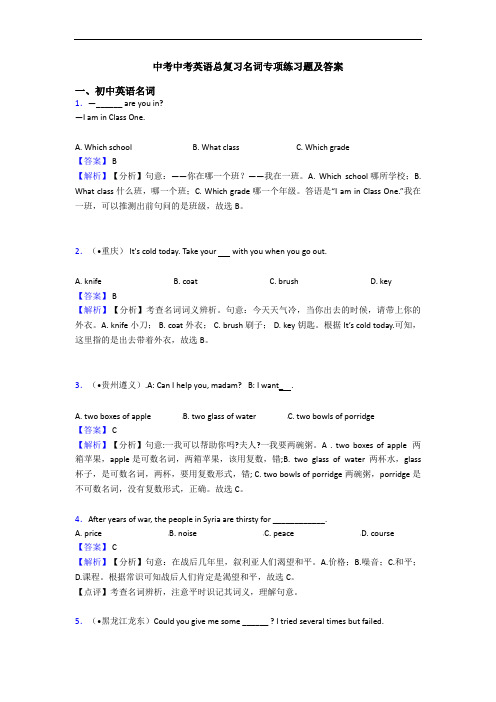
中考中考英语总复习名词专项练习题及答案一、初中英语名词1.—______ are you in?—I am in Class One.A. Which schoolB. What classC. Which grade【答案】 B【解析】【分析】句意:——你在哪一个班?——我在一班。
A. Which school哪所学校;B. What class什么班,哪一个班;C. Which grade哪一个年级。
答语是“I am in Class One.”我在一班,可以推测出前句问的是班级,故选B。
2.(•重庆) It's cold today. Take your with you when you go out.A. knifeB. coatC. brushD. key【答案】 B【解析】【分析】考查名词词义辨析。
句意:今天天气冷,当你出去的时候,请带上你的外衣。
A. knife 小刀; B. coat外衣; C. brush 刷子; D. key钥匙。
根据It’s cold today.可知,这里指的是出去带着外衣,故选B。
3.(•贵州遵义).A: Can I help you, madam? B: I want_ .A. two boxes of appleB. two glass of waterC. two bowls of porridge【答案】 C【解析】【分析】句意:一我可以帮助你吗?夫人?一我要两碗粥。
A . two boxes of apple 两箱苹果,apple是可数名词,两箱苹果,该用复数,错;B. two glass of water 两杯水,glass 杯子,是可数名词,两杯,要用复数形式,错; C. two bowls of porridge两碗粥,porridge是不可数名词,没有复数形式,正确。
故选C。
4.After years of war, the people in Syria are thirsty for ____________.A. priceB. noiseC. peaceD. course【答案】 C【解析】【分析】句意:在战后几年里,叙利亚人们渴望和平。
英语名词练习题及答案初三

英语名词练习题及答案初三英语名词练习题及答案初三英语是一门广泛使用的语言,掌握好英语的基础知识对于我们的学习和工作都非常重要。
而名词作为英语语法中的一部分,更是我们学习英语的基础。
下面是一些初三英语名词练习题及答案,希望对大家的学习有所帮助。
练习题一:选择正确的名词形式填空。
1. The _______ of the book is very interesting. (author/authors)2. I bought three _______ of milk from the supermarket. (bottle/bottles)3. The _______ of the cake was delicious. (taste/tastes)4. The _______ of the car is red. (color/colors)5. My sister is a _______ in a hospital. (nurse/nurses)答案:1. author 2. bottles 3. taste 4. color 5. nurse练习题二:根据所给句子,选择正确的名词形式填空。
1. I need two _______ for my new project. (box/boxes)2. The _______ of the movie was amazing. (end/ends)3. The _______ of the book is very long. (chapter/chapters)4. Can you pass me the _______ on the table? (pen/pens)5. The _______ of the flower is beautiful. (smell/smells)答案:1. boxes 2. end 3. chapter 4. pens 5. smell练习题三:根据所给句子,选择正确的名词形式填空。
中考总复习 名词练习题(含答案)
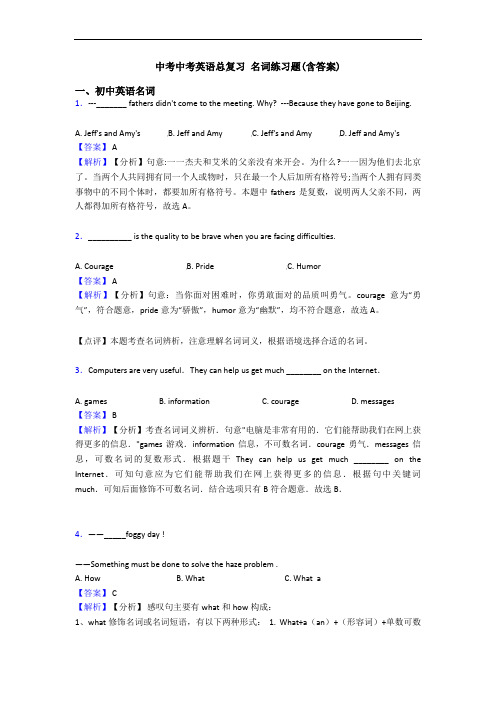
中考中考英语总复习名词练习题(含答案)一、初中英语名词1.---_______ fathers didn't come to the meeting. Why? ---Because they have gone to Beijing.A. Jeff's and Amy'sB. Jeff and AmyC. Jeff's and AmyD. Jeff and Amy's【答案】 A【解析】【分析】句意:一一杰夫和艾米的父亲没有来开会。
为什么?一一因为他们去北京了。
当两个人共同拥有同一个人或物时,只在最一个人后加所有格符号;当两个人拥有同类事物中的不同个体时,都要加所有格符号。
本题中fathers是复数,说明两人父亲不同,两人都得加所有格符号,故选A。
2.__________ is the quality to be brave when you are facing difficulties.A. CourageB. PrideC. Humor【答案】 A【解析】【分析】句意:当你面对困难时,你勇敢面对的品质叫勇气。
courage意为“勇气”,符合题意,pride意为“骄傲”,humor意为“幽默”,均不符合题意,故选A。
【点评】本题考查名词辨析,注意理解名词词义,根据语境选择合适的名词。
3.Computers are very useful.They can help us get much ________ on the Internet.A. gamesB. informationC. courageD. messages【答案】 B【解析】【分析】考查名词词义辨析.句意"电脑是非常有用的.它们能帮助我们在网上获得更多的信息."games游戏.information信息,不可数名词.courage勇气.messages信息,可数名词的复数形式.根据题干They can help us get much ________ on the Internet.可知句意应为它们能帮助我们在网上获得更多的信息.根据句中关键词much.可知后面修饰不可数名词.结合选项只有B符合题意.故选B.4.——_____foggy day !——Something must be done to solve the haze problem .A. HowB. WhatC. What a【答案】 C【解析】【分析】感叹句主要有what和how构成:1、what修饰名词或名词短语,有以下两种形式:1. What+a(an)+(形容词)+单数可数名词+主语+谓语!或是:What+名词词组+主语+谓语!2. What+(形容词)+可数名词复数或不可数名词+主语+谓语!2、How引导的感叹句。
初三英语名词专项练习题

初三英语名词专项练习题1. 单选题:(1) Tom always eats an apple ______ breakfast.A. withB. onC. forD. at(2) I found _______ interesting book at the bookstore.A. anB. aC. theD. /(3) The ______ of the boys are good at math.A. mostB. muchC. manyD. more(4) Please give me _______ information about the project.A. someB. aC. muchD. any(5) There are _______ students in our class.A. two hundredB. two hundredsC. two hundreds ofD. two hundred of2. 完型填空:Henry is a 6-year-old boy who loves __1___. He has a big __2___ of toy cars in his room. Yesterday, he __3___ a new toy car from his parents as a birthday gift. He played with it the whole afternoon.Henry has an __4__ dream. He wants to be a __5___ one day. He dreams of __6____ the world and taking photos of different places andpeople. He often looks at the pictures in travel magazines and __7___ stories about famous photographers.Every day, his father tells him, “Follow your dreams, Henry. You can be anything __8__ you work hard.” Henry believes in his father’s words and__9__ his dream.One day, when Henry __10___ eight years old, he went on his first trip. His father took him to the beach, and it was the __11___ time he saw the ocean. He felt very __12___ and couldn’t wait to take his first photo. He took out his __13____ and looked through the __14__. However, when he pressed the button, nothing __15___. His camera was broken.Henry was __16___. He couldn’t take any photos during the trip. But he didn’t give __17___. He knew that he couldn’t __18___ his dream just because of a broken camera. He decided to save money to buy a new one. He did chores for his parents, helped his grandmother, and even sold some of his toy cars. After a few __19___, Henry finally had enough money to buy a new camera. He was so happy.Now, Henry is ten years old and he always carries his camera with him wherever he goes. He takes photos of everything he likes and dreams of becoming a __20___ one day.(1) A. books B. sports C. cars D. animals(2) A. bag B. box C. pile D. set(3) A. had B. got C. received D. bought(4) A. ordinary B. famous C. smart D. helpful(5) A. pilot B. doctor C. teacher D. photographer(6) A. exploring B. visiting C. watching D. reading(7) A. hear B. tell C. write D. see(8) A. if B. because C. although D. unless(9) A. forgets B. follows C. misses D. understands(10) A. reached B. turned C. became D. woke(11) A. last B. first C. only D. best(12) A. angry B. afraid C. excited D. tired(13) A. notebook B. bag C. camera D. phone(14) A. window B. lens C. screen D. door(15) A. happened B. showed C. worked D. moved(16) A. disappointed B. satisfied C. surprised D. encouraged(17) A. up B. in C. away D. out(18) A. achieve B. drop C. forget D. give(19) A. weeks B. months C. years D. days(20) A. teacher B. pilot C. singer D. photographer3. 阅读理解:(1) Once upon a time, there was a lonely bird named Simon. Simon was sad because he had no friends. He saw a group of birds flying south forwinter every year, but he was afraid to join them because he wasn’t as strong or as big as the other birds.One day, Simon saw a group of birds building nests. He decided to join them and maybe they would be his friends. So every day, he flew to the tree where the group was building nests and helped them collect leaves and build homes. The other birds were surprised to see Simon, but they noticed how hard he worked and how kind he was. They started talking to him and taught him how to fly higher and stronger.Spring came and the birds were ready to fly north again. They asked Simon to join them and he agreed. Simon was nervous as they started their journey, but he kept up with the other birds and soon learned to fly as high and as fast as they did. The other birds were impressed by Simon’s determination and courage. They all became good friends.1. What did Simon see every year?A. A group of birds building nests.B. A group of birds flying south for winter.C. A group of birds flying north for spring.D. A group of birds collecting leaves.2. Why did Simon decide to join the birds building nests?A. Because he wanted to fly south for winter.B. Because he wanted to learn how to fly higher.C. Because he knew they would teach him to be strong.D. Because he wanted to make friends with them.3. What did the other birds think of Simon at first?A. They were afraid of him because he was lonely.B. They were surprised to see him and be his friends.C. They were angry with him for not being as strong.D. They were unhappy because he couldn’t fly higher.4. What happened after spring came?A. Simon flew away by himself.B. Simon became friends with the other birds.C. Simon helped build homes for the other birds.D. Simon learned how to fly as high as the other birds.(2) One bright sunny day, two friends named Ben and Sam decided to go fishing. They packed their fishing rods, bait, and some sandwiches and went to a nearby river. They found a nice spot by the river and put their fishing rods into the water.An hour went by, but none of the friends caught any fish. They started to feel disappointed and hungry. Sam suggested eating the sandwiches, but Ben insisted they should wait a little longer.After another hour, they still hadn't caught anything. Ben's stomach growled loudly, and he finally agreed to eat the sandwiches. As they wereeating, a fish jumped out of the water and splashed back in. Ben and Sam looked at each other in surprise.They quickly cast their fishing rods back into the water and soon enough, they both caught a fish. They laughed and cheered, realizing that they had been too focused on their hunger and impatience before.From that day on, Ben and Sam learned an important lesson about patience. They knew that waiting patiently would bring them better chances of success.1. What did Ben and Sam bring for their fishing trip?A. Fishing rods and bait.B. Fishing rods and sandwiches.C. Fishing rods, sandwiches, and bait.D. Fishing rods, sandwiches, and fishing nets.2. Why did Sam suggest eating the sandwiches?A. They hadn't caught any fish yet.B. He wanted to rest for a little bit.C. He didn't like fishing very much.D. It was lunchtime and he was hungry.3. What happened while Ben and Sam were eating?A. They heard noises from the water.B. They saw a fish jump out of the water.C. They caught a fish without using their rods.D. They decided to go home because they were hungry.4. What lesson did Ben and Sam learn from this experience?A. Fishing is a fun and relaxing activity.B. Patience is important for success.C. They should always bring more sandwiches.D. It is better to fish in the morning than the afternoon.参考答案:单选题:(1) C. for(2) A. an(3) B. much(4) A. some(5) A. two hundred完型填空:(1) C. cars(2) B. box(3) B. got(4) A. ordinary(5) D. photographer(6) A. exploring(7) C. write(8) A. if(9) B. follows(10) B. turned(11) B. first(12) C. excited(13) C. camera(14) B. lens(15) C. worked(16) A. disappointed(17) D. out(18) D. give(19) B. months(20) D. photographer阅读理解:(1) B. A group of birds flying south for winter.(2) D. Because he wanted to make friends with them.(3) B. They were surprised to see him and be his friends.(4) B. Simon became friends with the other birds. (2)(1) A. Fishing rods and sandwiches.(2) A. They hadn't caught any fish yet.(3) B. They saw a fish jump out of the water.(4) B. Patience is important for success.。
英语名词练习题及答案初三

英语名词练习题及答案初三一、选择题1. The _______ of the old building is very beautiful.A. roofB. roofsC. roof’sD. roofs’正确答案:B. roofs2. He has a great interest in _______.A. musicB. mathsC. physicsD. chemistry正确答案:A. music3. There is a _______ in the room.A. deskB. chairC. tableD. bookshelf正确答案:D. bookshelf4. The _______ of the novel is very famous.A. writerB. readersC. titleD. plot正确答案:C. title5. She is good at playing _______.A. pianoB. the pianoC. pianosD. the pianos正确答案:B. the piano二、填空题6. The _______ of the school are very kind to the students. [答案:teachers]7. We should take good care of our _______.[答案:environment]8. The _______ of the city is very high.[答案:population]9. He has a collection of _______.[答案:stamps]10. The _______ of the house is very modern.[答案:design]三、改错题11. The childrens are playing in the garden.[答案:The children are playing in the garden.]12. I have many books of science fictions.[答案:I have many science fiction books.]13. She likes to read news about the world.[答案:She likes to read news about the world.]14. The boys and girls are learning historys.[答案:The boys and girls are learning history.]15. There are many informations in the book.[答案:There is a lot of information in the book.]四、翻译题16. 他喜欢收集邮票。
初中英语2024届中考复习名词练习题(共50题,附参考答案)

中考英语名词练习题班级考号姓名总分( )1.The Three Gorges Dam produces ________ for millions of people in China.A.electricityB.influenceC.transportD.technology( )2. ---Do you have this T-shirt in a small ________?---I’m a fraid not.It only comes in medium.A.sizeB.colourC.materialD.taste( )3.Can you give me some ________, please?A.messageB.suggestionC.advicermations( )4.---What do you think of The Belt and Road Initiative(一带一路倡议)?---Great! It will help China improve the ______ with those related countries. A.relationship B.agreementC.environmentrmation( )5.My mother has a poor ______ of direction, so she is always afraid to go out alone.A.sceneB.silenceC.serviceD.sense( )6.My ______ of this weekend’s activity is going out with some good friends. A.idea B.opinionC.mindD.thought( )7.Wang Yaping and Liu Yang are our ________ in China.We’re proud of them.A.woman astronautsB.women astronautC.women astronautsD.woman astronaut( )8.At the _________ , Kate was looked over carefully by Mr.Brown.A.doctorB.doctorsC.doctor’sD.doctors’( )9.---John, is the book on the desk yours?---No, it’s my _________.She left it here yesterday.A.sister’sB.sisterC.sisters’D.sisters( )10.---Excuse me! Is this _________ new house?---Yes, it’s theirs.The parents of them bought it last September.A.Lucy and Lily’sB.Lucy’s and LilyC.Lucy’s and Lily’sD.Lucy and Lily( )11.Le’s stop by the _______ on the way there.A.flowers shopB.flower’s shopC.flower shopD.flowers’ shop( )12.---How far is it from Chongqing to Guiyang?---It’s about two ______ ride by high-speed train.A.hourB.hour’sC.hoursD.hours’( )13. They are thirsty.Will you please give them_________?A.some bottles of watersB.some bottles of waterC.some bottle of waterD.some bottle of waters( )14.---What kind of noodles would you like?---I’d like some _____ noodles.A.carrotsB.beefC.potatoesD.vegetables( )15.---Good news! We will have a _____ holiday.--- I’ve heard of it .but i t’s coming in ________.A.three days; three days’ timeB.three days’ ; three days’C.three-day; three daysD.three days; three-day time( )16.Many foreigners came to our school last week, including three _____ and four ____.A.German, AmericanB.Germans, AmericanC.Germans, AmericansD.German, Americans( )17.The ______ often eat grass on the hill.A.chickenB.horseC.cowD.sheep( )18.---May I take your order, sir?---_____________A.Chicken with vegetables and two bowls of ricesB.Chicken with vegetables and two bowls of riceC.Chickens with vegetable and two bowl of riceD.Chickens with vegetable and two bowls of rice( )19.I’m so hungry.Please give me _____ to eat.A.three breadB.three pieces of breadC. three pieces of breadsD.three piece of bread( )20.We should keep rooms clean and tidy because ______ may appear in dirty places.A.mouseB.miceC.mousesD.mouse’s( )21.I’m not hungry at all because I have ju st had much _______.A.breadB.pearsC.eggsD.noodles( )22.Because of a large amount of ______, there are few valuable ______ in the mountains now.A.pollutions; plantsB.pollutions; plantC.pollution; plantsD.pollution; plant( )23.The three ______ upstairs are too small to have enough ______ for a double bed.A.room; roomB.room; roomsC.rooms; roomD.rooms; rooms( )24.It’s sports time.Most _____ students in Class One are playing football on the playground.A.boyB.boysC.boy’sD.boys’( )25.The mobile phone sells for ¥5,000, and it is much higher than its real _______.A.costB.valueC.priceD.prize( )26.The family were sitting at the lunch table when someone came to tell them what had happened at __.A.Mr.BrownB.Mr.Brown’sC.Mr.Browns’D.Mr.Browns( )27.We usually have a seven ______ holiday every National Day.A.daysB.day’C.day’sD.days’( )28.I often have trouble with my ______ because I have eaten too much sweet food.A.toothB.teethC.footD.feet( )29.Lights are out.The concert is to begin.The fans hold their _____ for Jay Chou’s appearance.A.moneyB.smileC.handD.breath( )30.We should often help to do some housework on _____ instead of doing nothing.A.Mothers DayB.Mother’s DayC.Mothers’ DayD.Mother Day31.Which team was the _________ (win) of the 20th FIFA World Cup?32.None of them talked.They finished their lunch in _________ (silent).33.His ________ (ill) is even worse than I thought it would be.34.My dream is to be a famous doctor and save patients’ ________ (life).35.Westerners eat with forks and _______ (knife), while we Chinese eat with chopsticks.36.Tom is always _________ (friend) to others and helps them deal with problems.37.Walk slowly along the river and you can enjoy the _______ (beautiful) of our town.38.The sun brings us light and ________ (hot) every day.39.Do you know what your ________ (parent) favourite colours are?40.They won the gold medal in the ______ (man) football match.41.There are different kinds of interesting _______ (place) in Liaoning Province.42.Carrots and ________ (tomato) are my favourite vegetables.43.Would you mind giving me some _________ (information) on how to plant trees?44.There are many ________ (deer) eating on the hill.45.Greenhouse gases are __________ (harm) to the environment.46.All of us look forward to _______ (China) development.47.The mother tells several ________ (story) to her baby every night before sleep.48.Mr.Smith is _________ (absence) from the meeting today.49.Tomorrow will be _______ (sun).Why not go for a trip together?50.To keep healthy, you should do sports and have a balanced _______ (diet).附:参考答案:1 -- 5 AACAD 6 -- 10 ACCAA 11 -- 15 CDBBC16 --20 CDBBB 21 -- 25 ACCAB 26 -- 30 BDBDB31.winner 32.silence 33.illness 34.lives 35.knives36.friendly 37.beauty 38.heat 39.parents' 40.men's41.places 42.tomatoes rmation 44.deer 45.harmful46.China's 47.stories 48.absent 49.sunny 50.diet。
九年级英语名词专项练习(附答案)
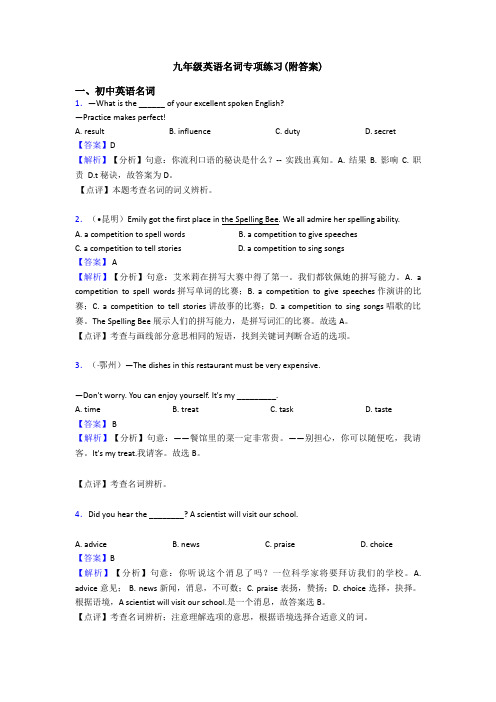
九年级英语名词专项练习(附答案)一、初中英语名词1.—What is the ______ of your excellent spoken English?—Practice makes perfect!A. resultB. influenceC. dutyD. secret【答案】D【解析】【分析】句意:你流利口语的秘诀是什么?-- 实践出真知。
A. 结果B. 影响C. 职责 D.t秘诀,故答案为D。
【点评】本题考查名词的词义辨析。
2.(•昆明)Emily got the first place in the Spelling Bee. We all admire her spelling ability.A. a competition to spell wordsB. a competition to give speechesC. a competition to tell storiesD. a competition to sing songs【答案】 A【解析】【分析】句意:艾米莉在拼写大赛中得了第一。
我们都钦佩她的拼写能力。
A. a competition to spell words拼写单词的比赛;B. a competition to give speeches作演讲的比赛;C. a competition to tell stories讲故事的比赛;D. a competition to sing songs唱歌的比赛。
The Spelling Bee展示人们的拼写能力,是拼写词汇的比赛。
故选A。
【点评】考查与画线部分意思相同的短语,找到关键词判断合适的选项。
3.(·鄂州)—The dishes in this restaurant must be very expensive.—Don't worry. You can enjoy yourself. It's my _________.A. timeB. treatC. taskD. taste【答案】 B【解析】【分析】句意:——餐馆里的菜一定非常贵。
中考九年级英语名词训练题
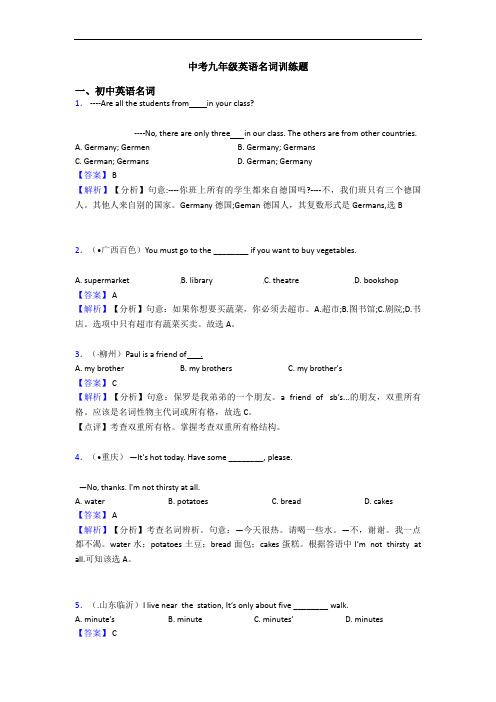
中考九年级英语名词训练题一、初中英语名词1. ----Are all the students from in your class?----No, there are only three in our class. The others are from other countries.A. Germany; GermenB. Germany; GermansC. German; GermansD. German; Germany【答案】 B【解析】【分析】句意:----你班上所有的学生都来自德国吗?----不,我们班只有三个德国人。
其他人来自别的国家。
Germany德国;Geman德国人,其复数形式是Germans,选B2.(•广西百色)You must go to the ________ if you want to buy vegetables.A. supermarketB. libraryC. theatreD. bookshop【答案】 A【解析】【分析】句意:如果你想要买蔬菜,你必须去超市。
A.超市;B.图书馆;C.剧院;D.书店。
选项中只有超市有蔬菜买卖。
故选A。
3.(·柳州)Paul is a friend of .A. my brotherB. my brothersC. my brother's【答案】 C【解析】【分析】句意:保罗是我弟弟的一个朋友。
a friend of sb's...的朋友,双重所有格。
应该是名词性物主代词或所有格,故选C。
【点评】考查双重所有格。
掌握考查双重所有格结构。
4.(•重庆)—It's hot today. Have some ________, please.—No, thanks. I'm not thirsty at all.A. waterB. potatoesC. breadD. cakes【答案】 A【解析】【分析】考查名词辨析。
英语名词练习题及答案初三
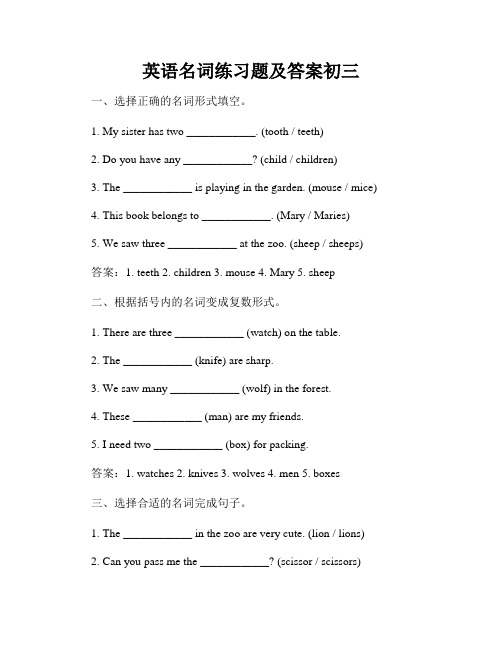
英语名词练习题及答案初三一、选择正确的名词形式填空。
1. My sister has two ____________. (tooth / teeth)2. Do you have any ____________? (child / children)3. The ____________ is playing in the garden. (mouse / mice)4. This book belongs to ____________. (Mary / Maries)5. We saw three ____________ at the zoo. (sheep / sheeps)答案:1. teeth 2. children 3. mouse 4. Mary 5. sheep二、根据括号内的名词变成复数形式。
1. There are three ____________ (watch) on the table.2. The ____________ (knife) are sharp.3. We saw many ____________ (wolf) in the forest.4. These ____________ (man) are my friends.5. I need two ____________ (box) for packing.答案:1. watches 2. knives 3. wolves 4. men 5. boxes三、选择合适的名词完成句子。
1. The ____________ in the zoo are very cute. (lion / lions)2. Can you pass me the ____________? (scissor / scissors)3. The ____________ in the bedroom need to be cleaned. (shelf / shelves)4. She bought three ____________ for her birthday party. (cake / cakes)5. There are many colorful ____________ in the sky. (kite / kites)答案:1. lions 2. scissors 3. shelves 4. cakes 5. kites四、给下列句子中的名词选择正确的复数形式。
名词练习题初三

名词练习题初三名词是英语语法中的重要部分,它用于指称人、物、地点、概念等。
掌握名词的用法对于初三学生来说至关重要。
本文将为你提供一些名词练习题,帮助你巩固对名词的理解和应用。
练习题一:选出下列句子中的名词。
1. The dog chased the cat up the tree.2. The students are studying for the exam.3. She received a beautiful bouquet of flowers.4. The car parked in front of the building belongs to my neighbor.5. We had a delicious dinner at the new restaurant downtown.练习题二:完成下列句子,填入合适的名词形式。
1. The ________ of the meeting will be announced tomorrow. (organize)2. I bought a new pair of ________ for the party. (shoe)3. The ________ of the book is very interesting. (conclude)4. She showed great ________ in solving the difficult math problem. (determine)5. The ________ of the concert were mesmerizing. (perform)练习题三:将下列集体名词转化为个体名词。
1. committee3. herd4. team5. staff练习题四:根据句子意思,选出合适的名词性物主代词。
1. This book is ________.a) mineb) myc) me2. Are these gloves ________?a) theirb) theirsc) them3. The keys are ________.a) yourb) yoursc) you4. This is not her pencil; it's ________.a) herc) she5. The concert was cancelled due to ________ absence.a) hisb) himc) he练习题五:根据句子意思,选出合适的名词形式。
- 1、下载文档前请自行甄别文档内容的完整性,平台不提供额外的编辑、内容补充、找答案等附加服务。
- 2、"仅部分预览"的文档,不可在线预览部分如存在完整性等问题,可反馈申请退款(可完整预览的文档不适用该条件!)。
- 3、如文档侵犯您的权益,请联系客服反馈,我们会尽快为您处理(人工客服工作时间:9:00-18:30)。
初三名词复习练习题复习名词的用法:一、名词可分为两大类:1) 普通名词2) 专有名词名词又可分为:1) 可数名词(countable noun) / n[c],它有单、复数之分。
2) 不可数名词(uncountable noun) / n[u],它一般不分单数和复数。
二、名词的数:可数名词有单数和复数两种形式。
主要变法如下:(1)一般情况在词尾加-s,如:book→books,girl→girls,boy→boys(2)以s,x,ch,sh,结尾的词加-es,如:box→b oxes,class→classes,(3)以辅音字母+y结尾的词变“y”为“i”再加-es, 如:city→cities, factory→factories,(4)以o结尾的词,一般说来有生命的词加-es,无生命的加-s,如:hero tomato potato Negropiano zoo radio(5)以f或fe结尾的词,多数变“f”为“v”再加-es,如:knife→knives,leaf→leaves, half→halves(6)不规则的复数形式,如:man→men,woman→women,tooth→teeth,foot→feet,child→children,mouse→mice 【注意】1) 与man和woman构成的合成词,其复数形式也是-men和-women。
例如:an Englishman→two Englishmen。
但German→Germans;2) man worker→men workers, woman teacher→ women teachers3) 有些名词单复数一样,例如:Chinese,Japanese,sheep,deer,fish等。
但当fish表示不同种类的鱼时,可以加-es口诀;男人女人a变e,孩子后加ren;中国人和日本人,棉羊鹿鱼形不变;脚和牙齿还有鹅,就把oo变ee;mouse、mice是老鼠,公牛ox加en;人们警察牵小牛,单数形式复数意;男医生和女医生,man和doctor都变身。
练习题一) 可数名词的复数规则变化1. map__________ car__________2. brush__________ watch__________3. baby__________ country__________4. wolf___________ wife__________二) 可数名词复数不规则变化5. child__________ tooth__________ mouse__________ man__________6. German________ Frenchman_________ Chinese________7. deer_______ sheep________三、不可数名词“量”的表示(1)用much, a little, a lot of / lots of, some, any等表示多少,如:The rich man has a lot of money.Is there any water in the glass?(2)用a piece of, a glass of 等这类定语,如:a piece of paper / bread a bottle of orange,a glass of milk three bags of rice不可数名词一般没有复数形式, 说明其数量时, 要用有关计量名词。
如:five cups of tea, three bowls of rice,可用piece, glass, cup, bottle, bowl, loaf (条), bar (块), tin (听,罐), basket, bag, box, kilo, pound来表达“量”。
如:a loaf of bread 一条面包 a bar of soap 一块肥皂 a tin of tobacco 一听/罐烟丝注意以下几点:▲不可数名词没有复数形式,也不能用不定冠词 a , an 及数词修饰。
但可用some, any, much,a lot of,a little等直接修饰。
如:some meat, some bread,▲不可数名词前通常用量词来表示具体的数。
如:a glass of water, two cups of tea, five pieces of bread。
量词需要用复数形式。
▲不可数名词作主语时,谓语动词用单数形式。
如:These is some water in the bottle. 瓶里有些水。
Is there any rice in the bag? 袋子里有米吗?▲若不可数名词前有复数数量词修饰时,谓语动词用复数形式。
如:There are three bottles of orange on the table. 桌上有三瓶桔汁。
试比较:There is some orange on the table.▲对不可数名词前的修饰语提问,疑问词用how much。
如:They want two cups of tea. →How much tea do they want?There is some milk in the glass . →How much milk is there is the glass ?▲对不可数名词前量词部分的修饰语提问题,疑问词用how many。
如:They want two cups of tea. →How many cups of tea do they want?▲不可数名词表示特指时可用定冠词the修饰。
如:The bread on the table is Li Lei’s.桌上的面包是李磊的。
▲有些名词即可作可数名词,也可作不可数名词,但意思却大不相同。
如:glass 作可数名词,意思是“玻璃杯”,作为不可数名词,意思是“玻璃”;room 作可数名词,意思是“房间”,作不可数名词,意思是“空间”。
名词所有格一、’s 所有格的用法1. 表示有生命的东西的名词末尾加's。
如:Jim's bed the man's wife children's toys2. 以-es或-s结尾的名词末尾及名词的复数加’。
如:the students' books Teachers' Day my boss' office3. 有些表示时间、距离、度量衡、价值、自然现象、国家、城镇等无生命东西的名词,也可以加's构成所有格。
如:today's newspaper five minutes' walk = five minutes walk the moon's rays (月光)数词+名词,这个名词通常用单数,中间用连字符。
如:five-minute rest, an 11-year-old boy4. And 连接的两个词语,表示两者共同拥有的人或物(共有)时,只需要后一个名词加's (或')即可。
如果表示两者各自的所属关系(各自所有),则每个名词词尾都加上's(或')。
如:Joan and Jane's room(共同所有) Joan's and Jane's room (各自所有)5. 's所有格所修饰的词的省略现象(1)表示诊所、店铺或某人的家等地点名词,其名词所有格后的被修饰语常常省略。
如:I met her at the doctor's (office). 在诊所He has gone to the tailor's (shop). 服装店(2)名词所有格所修饰的词,如果前面已经提到过,往往可以省略,以免重复。
如:The bike is not mine, but Wang Ping's. 这辆自行车不是我的,是王平的。
二、of 所有格的用法由of加名词构成,其用法归纳如下:1. of所有格一般用于无生命的东西的名词中。
如:a map of the world the story of a hero the title of the film2. 表示有生命的东西的名词,有时也可以用of所有格。
如:the children of the family 那家的孩子们3. 修饰词较多时也可用of 所有格。
如:the very long and graceful tail of the black cat 黑猫的又长又美的尾巴某些of所有格和's所有格可以互换。
the son of a poor farmer =a poor farmer’s son 一个贫农的儿子但有时含义却不相同,请比较下面的例子:an old woman's story (一个老妇人讲自己的身世)the story of an old woman (别人讲一个老妇人的身世)三、双重所有格及其用法’s所有格和of所有格两种所有格形式结合在一起,构成"of+所有格"形式,即双重的所有格。
它通常表示部分观念,即全体中的一部分,在意义上与"one of..."相似,它主要修饰of 短语之前的那个名词。
此外,双重所有格与指示代词连用时,常带有感情色彩,如赞赏、不满、厌恶等。
它的主要形式如下:1. 名词+of+名词性物主代词。
例如:a good friend of mine 我的一个好朋友an interesting story of his 他的有趣的经历2. 名词+of+'s所有格。
例如:He is a friend of my sister's.(=one of my sister's friends)他是我姐姐的一个朋友。
试比较: a picture of Xiao Zhang 小张(本人)的照片a picture of Xiao Zhang's 小张(具有的照片中)的一张照片中考题练习:1. The action film has attracted millions of young people to the cinema.A. 130-minuteB. 130-minutesC. 130 minuteD.130 minutes2. The _____ often eat grass on the hill. A. chicken B. horse C. cow D. sheep3. ―Mr Li was sent to teach Chinese in an American high school last year.―Yes, I know. He told me he would never forget his pleasant ____ while working there.A. experimentsB. expressionsC. experiencesD. explorations4. —The mountain in our hometown isn't very _____.—I agree with you. Few _____ like to go sightseeing there.A. touristy, touristsB. touristy, tourC. tourists, touristyD. tourist, tourists5. —Jenny and Jane's ____ coming to my office. Can you help to find the girls?—No problem. They will be here_____.A. mothers are; in a momentB. mother is; at the momentC. mothers are; right awayD. mother is; in a moment6. —Mum, 1 am hungry. May 1 have some ______? —Of course. But don't eat too much.A. breadB. noodleC. dumplingD. hamburger7. Several years ago, people knew Yao Ming. But now he is well-known all over the world,not only in China.A. fewB. littleC. manyD. most8. —China is beginning to test the air quality with the new standard(标准)PM2.5.—Good news! Then the old PM10 standard will be .A. out of styleB. here and thereC. on the wayD. in a hurry9. I saw some ________ and ________ dancing in the street the day before yesterday.A. Germen; EnglishmenB. Germans; EnglishmansC. Germans; Englishmen10. They have got such a table.A. round wooden brownB. round brown woodenC. brown round woodenD. wooden round brown11. —It's a wise _____ to wear the white tie. It matches your shirt well.—Thanks very much.A. choiceB. supportC. mixtureD. honour12. —Do you think the of this skirt suits me? —Of course! You always look beautiful in red.A. sizeB. designC. priceD. color13. —I have great ______ in finishing the work by myself. Could you help me? —No problem.A. funB. successC. adviceD. difficulty14. —Where are the ______ students?—They are playing football with ______ students from Hilltop School.A. boys,/B. boys, theC. boy, /D. boy, the15. I’m so hungry. Please give me to eat.A. three breadB. three pieces of breadC. three pieces of breads完形填空Mr. and Mrs. king have lived in our town for nearly twenty years. They have a bookshop by the bus station. They’re __1__ to everybody and have a lot of friends. They often __2__ the poor students and sell them some books cheaply. So there’re many young men in their shop. Of course people __3__ them and their friends often call on (拜访) them and __4__ them. We can always hear their rooms are full of __5__ and quarrel. It was a Friday evening. Mr. and Mrs. King were going to have a picnic on the island the next __6__.It was a little far from our town. So they had to __7__ earlier than usual to catc h a six o’clock train. After __8__ a few friends came to see them while they were cooking some __9__ and drinks for the picnic. Mr. king and his wife had to stop __10__ them. They talked a lot and few of them looked at the __11__ on the wall. Mr. and Mrs. King were anxious but they couldn’t tell the visitors about it. The woman thought for a few __12__ and had an idea. She said to her __13__, “Oh, it’s eleven o’clock! You’d better stop talking, dear! Our guests are anxious to __14__!Mr. king heard this and stood up and said __15__ to the visitors and they left soon.1. A. had B. polite C. cold D. careful2. A. help B. hurt C. hit D. watch3. A. know B. understand C. meet D. like4. A. play with B. fight with C. talk with D. catch up with5. A. cry B. shout C. noise D. laugh6. A. morning B. afternoon C. evening D. laugh7. A. go to work B. get up C. go to sleep D. open the shop8. A. breakfast B. lunch C. supper D. meal9. A. clothes B. bags C. books D. food10. A. receive B. to receive C. receiving D. to accept11. A. phone B. photo C. clock D. picture12. A. minutes B. days C. weeks D. months13. A. visitor B. husband C. brother D. father14. A. go home B. go to bed C. go shopping D. have a rest15. A. hello B. goodbye C. sorry D. nothing。
